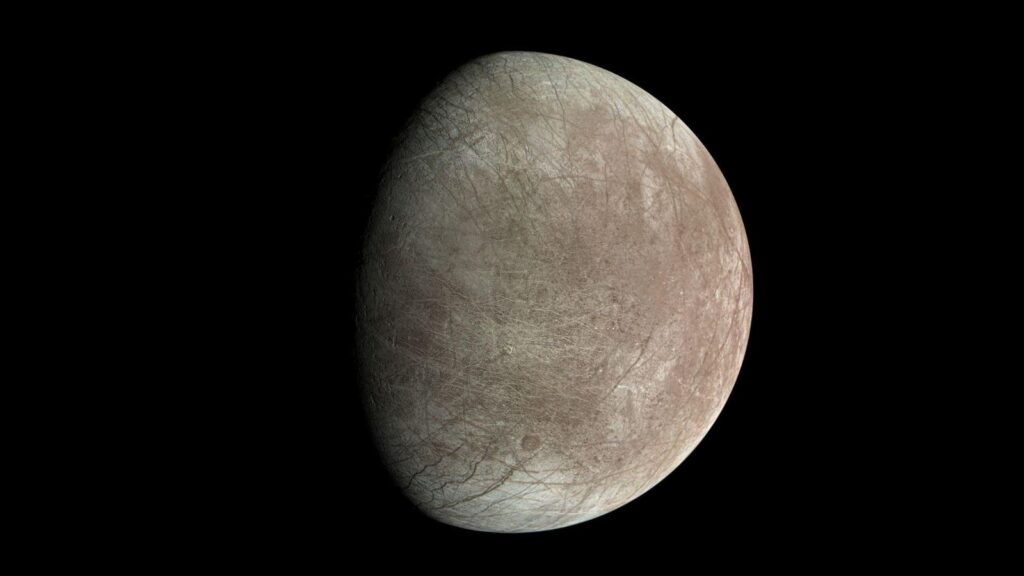Jupiter’s moon Europa was captured by the JunoCam instrument aboard NASA’s Juno spacecraft during … [+]
NASA and SpaceX have announced that their Europa Clipper mission, which will help planetary scientists determine if Europa could support life, will launch on Thursday, Oct. 10.
The mission will launch on a SpaceX Falcon Heavy rocket from Launch Complex 39A at NASA’s Kennedy Space Center in Florida, NASA confirmed in an email to media.
Europa—the fourth largest of Jupiter’s 79 moons—has intrigued scientists since a liquid ocean was discovered beneath its icy shell.
What Is Europa Clipper?
The Europa Clipper mission will help scientists determine if Europa, one of Jupiter’s icy moons, could support life. It will reach the Jupiter system in April 2030 and will spend four years studying Europa during at least 32 close flybys. It will photograph the moon’s icy surface in high resolution during each pass.
The largest spacecraft NASA has ever developed for a planetary mission, Clipper is about 16 feet tall and 100 feet wide—roughly the size of a basketball court—primarily thanks to its massive solar arrays.
The European Space Agency’s complimentary JUpiter ICy moons Explorer spacecraft, which launched last year and will reach the Jovian System in 2031, will go into orbit of Ganymede but also conduct close flybys of both Callisto and Europa.
The NASA Europa Clipper spacecraft is viewed inside a Spacecraft Assembly Facility clean room at … [+]
Why Is NASA Going To Europa?
Using one of the first telescopes, Galileo Galilei discovered Europa on Jan. 7, 1610, along with the other three so-called Galilean moons—Ganymede, Callisto and Io.
Europa has a diameter of 1,940 miles (3,122 kilometers)—slightly smaller than Earth’s moon—and takes 85 hours to orbit Jupiter. However, it’s more like a planet than a moon. It has a magnetic field as well as a tenuous oxygen atmosphere and a liquid iron core. Fractures in its icy surface make Europa look like a “veiny eyeball.”
It’s fascinated planetary scientists and astrobiologists since a salty ocean was found beneath its 11-mile-thick (18 km) icy shell. Suspected since Voyager 1 and 2 visited Jupiter for the first time in the late 1970s, that ocean was confirmed by NASA’s Galileo spacecraft in the late 1990s. The subterranean ocean is believed to be 40 to 100 miles (60 to 150 kilometers) deep.
What Will Europa Clipper Do?
According to NASA, Clipper’s primary science goal is to determine whether there are places below the surface of Europa that could support life. The mission’s three primary science objectives are to understand Europa’s composition and geology and learn more about the nature of the ice shell and the ocean beneath it—specifically its astrobiological potential.
The discovery of underground oceans in the outer solar system has arguably been one of the most significant findings in planetary science in the 21st century—and Europa is the poster child.
This graphic shows the location of water vapor detected over Europa’s south pole in observations … [+]
Europa’s Geysers And Glowing Colors
Europa may glow shades of green, blue and white, even at night, which Europa Clipper will observe to learn more about the composition of ice on the moon’s surface, a 2020 study revealed. How that composition varies could give scientists clues about whether Europa could host life.
Another 2020 paper revealed that NASA’s Galileo may have collected evidence that Europa occasionally releases some of the ocean’s water into space. In 2012, the Hubble Space Telescope detected evidence of hydrogen and oxygen in Europa’s atmosphere, and in 2016, it imaged what may be water vapor plumes erupting off the surface.
Wishing you clear skies and wide eyes.

